Critical Appraisal of a Research Article: PUBH7600 Assignment
VerifiedAdded on 2022/11/01
|6
|1366
|205
Report
AI Summary
This report presents a critical appraisal of a research article investigating the association between pro-inflammatory dietary patterns and bone fractures in women. The study, an 8-year longitudinal cohort study, examined the influence of dietary inflammatory index (DII) on fracture occurrence, considering factors like age, gender, and other bio-demographical parameters. The appraisal critically evaluates the study design, participant recruitment, exposure and outcome measurements, potential biases, and the methods used to control for confounding factors. The report also assesses the validity and reliability of the study's findings, including the interpretation of hazard ratios and the limitations of the study. The author concludes the study's validity and reliability, considering its strengths and weaknesses. The appraisal highlights the temporal relationships, and potential causal inferences. The report also discusses the generalizability of the findings and their implications for public health.
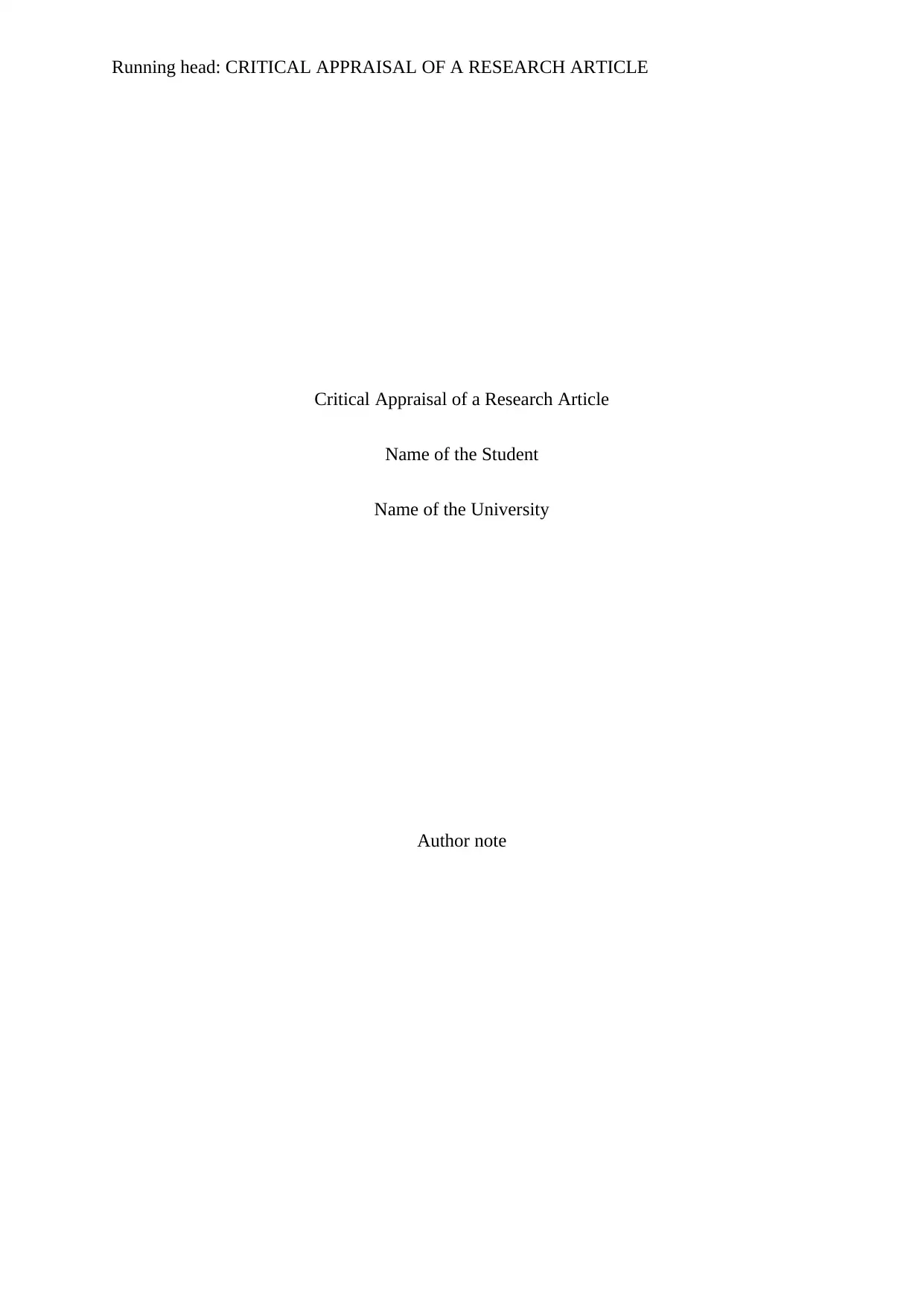
Running head: CRITICAL APPRAISAL OF A RESEARCH ARTICLE
Critical Appraisal of a Research Article
Name of the Student
Name of the University
Author note
Critical Appraisal of a Research Article
Name of the Student
Name of the University
Author note
Paraphrase This Document
Need a fresh take? Get an instant paraphrase of this document with our AI Paraphraser
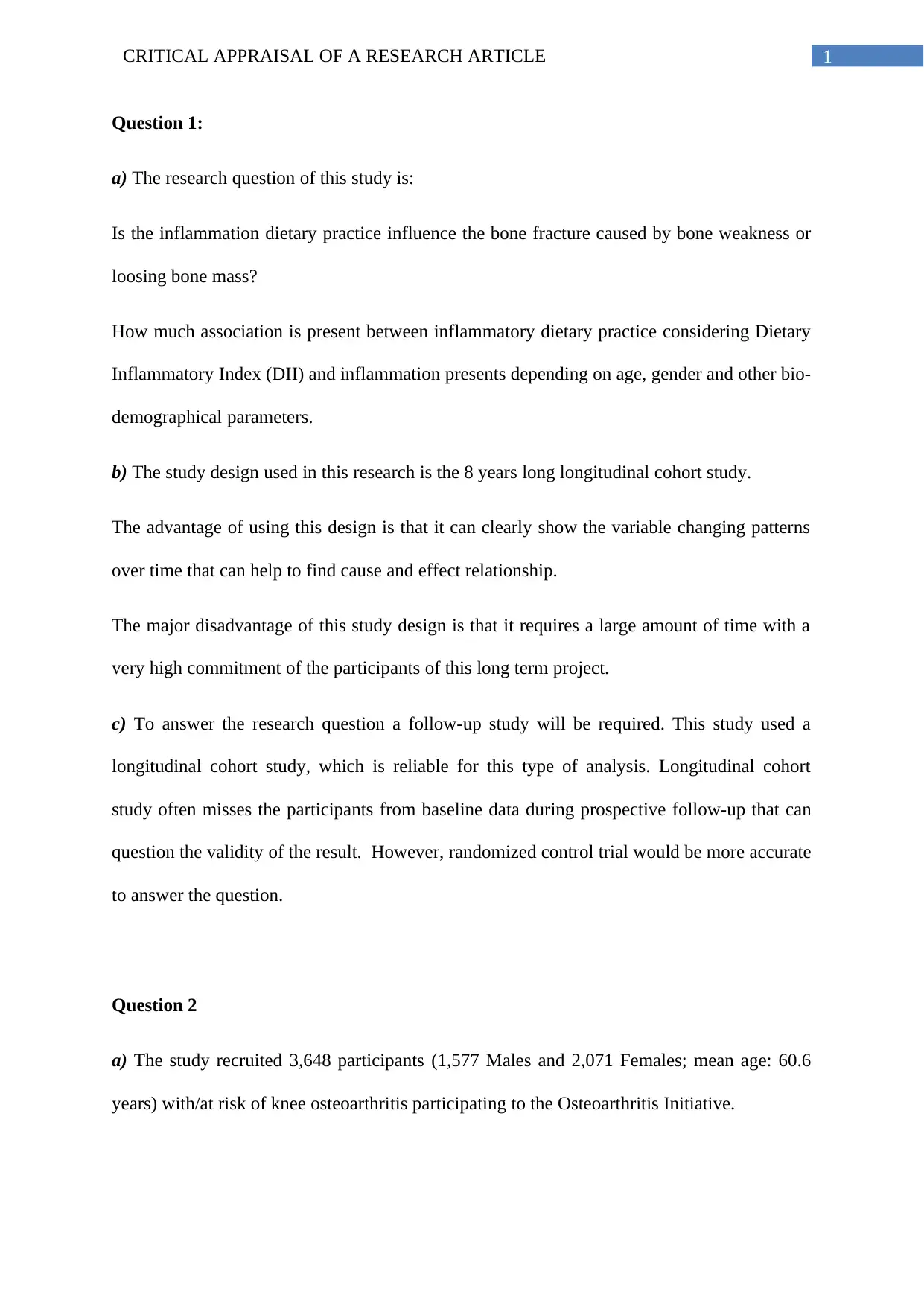
1CRITICAL APPRAISAL OF A RESEARCH ARTICLE
Question 1:
a) The research question of this study is:
Is the inflammation dietary practice influence the bone fracture caused by bone weakness or
loosing bone mass?
How much association is present between inflammatory dietary practice considering Dietary
Inflammatory Index (DII) and inflammation presents depending on age, gender and other bio-
demographical parameters.
b) The study design used in this research is the 8 years long longitudinal cohort study.
The advantage of using this design is that it can clearly show the variable changing patterns
over time that can help to find cause and effect relationship.
The major disadvantage of this study design is that it requires a large amount of time with a
very high commitment of the participants of this long term project.
c) To answer the research question a follow-up study will be required. This study used a
longitudinal cohort study, which is reliable for this type of analysis. Longitudinal cohort
study often misses the participants from baseline data during prospective follow-up that can
question the validity of the result. However, randomized control trial would be more accurate
to answer the question.
Question 2
a) The study recruited 3,648 participants (1,577 Males and 2,071 Females; mean age: 60.6
years) with/at risk of knee osteoarthritis participating to the Osteoarthritis Initiative.
Question 1:
a) The research question of this study is:
Is the inflammation dietary practice influence the bone fracture caused by bone weakness or
loosing bone mass?
How much association is present between inflammatory dietary practice considering Dietary
Inflammatory Index (DII) and inflammation presents depending on age, gender and other bio-
demographical parameters.
b) The study design used in this research is the 8 years long longitudinal cohort study.
The advantage of using this design is that it can clearly show the variable changing patterns
over time that can help to find cause and effect relationship.
The major disadvantage of this study design is that it requires a large amount of time with a
very high commitment of the participants of this long term project.
c) To answer the research question a follow-up study will be required. This study used a
longitudinal cohort study, which is reliable for this type of analysis. Longitudinal cohort
study often misses the participants from baseline data during prospective follow-up that can
question the validity of the result. However, randomized control trial would be more accurate
to answer the question.
Question 2
a) The study recruited 3,648 participants (1,577 Males and 2,071 Females; mean age: 60.6
years) with/at risk of knee osteoarthritis participating to the Osteoarthritis Initiative.
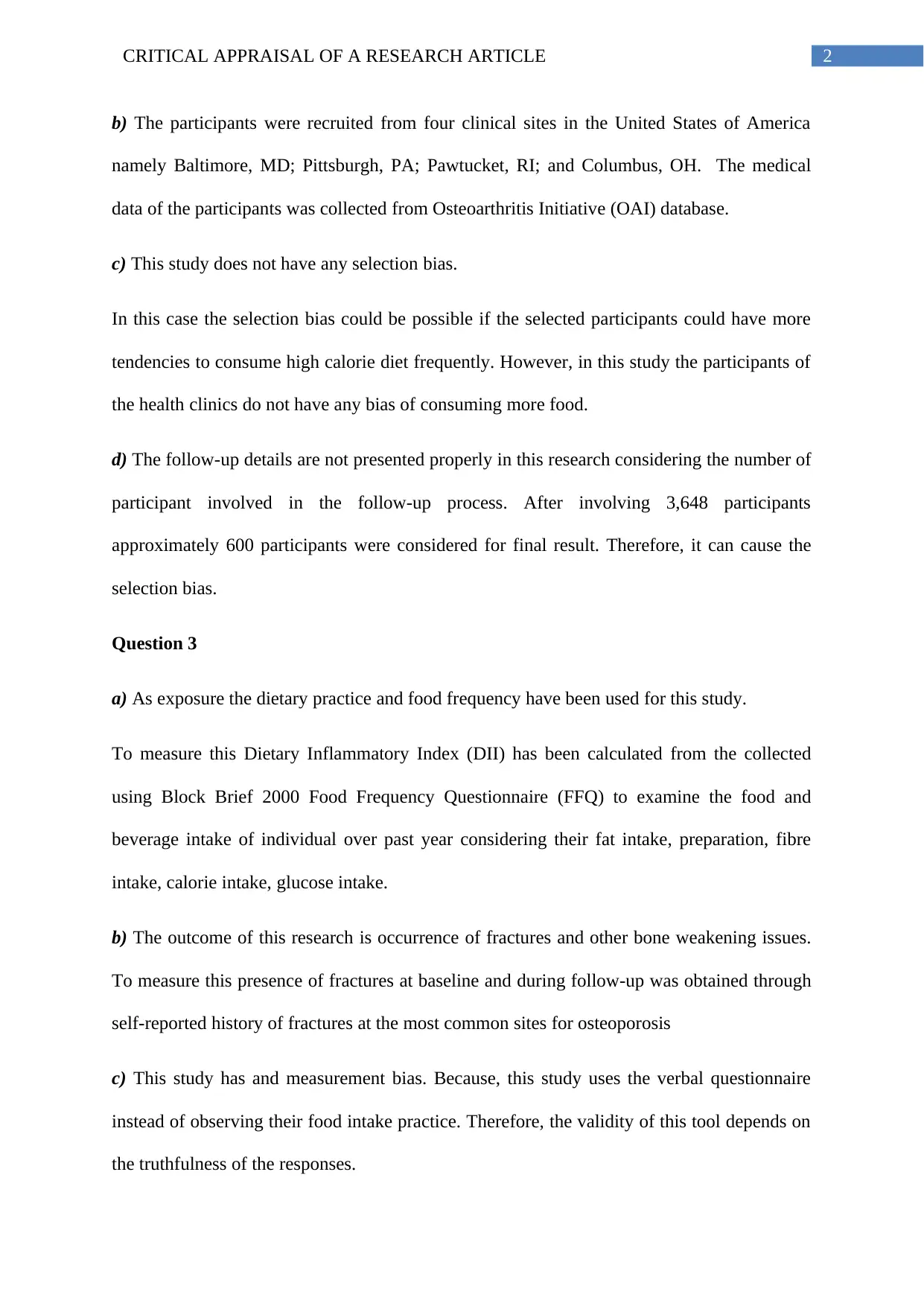
2CRITICAL APPRAISAL OF A RESEARCH ARTICLE
b) The participants were recruited from four clinical sites in the United States of America
namely Baltimore, MD; Pittsburgh, PA; Pawtucket, RI; and Columbus, OH. The medical
data of the participants was collected from Osteoarthritis Initiative (OAI) database.
c) This study does not have any selection bias.
In this case the selection bias could be possible if the selected participants could have more
tendencies to consume high calorie diet frequently. However, in this study the participants of
the health clinics do not have any bias of consuming more food.
d) The follow-up details are not presented properly in this research considering the number of
participant involved in the follow-up process. After involving 3,648 participants
approximately 600 participants were considered for final result. Therefore, it can cause the
selection bias.
Question 3
a) As exposure the dietary practice and food frequency have been used for this study.
To measure this Dietary Inflammatory Index (DII) has been calculated from the collected
using Block Brief 2000 Food Frequency Questionnaire (FFQ) to examine the food and
beverage intake of individual over past year considering their fat intake, preparation, fibre
intake, calorie intake, glucose intake.
b) The outcome of this research is occurrence of fractures and other bone weakening issues.
To measure this presence of fractures at baseline and during follow-up was obtained through
self-reported history of fractures at the most common sites for osteoporosis
c) This study has and measurement bias. Because, this study uses the verbal questionnaire
instead of observing their food intake practice. Therefore, the validity of this tool depends on
the truthfulness of the responses.
b) The participants were recruited from four clinical sites in the United States of America
namely Baltimore, MD; Pittsburgh, PA; Pawtucket, RI; and Columbus, OH. The medical
data of the participants was collected from Osteoarthritis Initiative (OAI) database.
c) This study does not have any selection bias.
In this case the selection bias could be possible if the selected participants could have more
tendencies to consume high calorie diet frequently. However, in this study the participants of
the health clinics do not have any bias of consuming more food.
d) The follow-up details are not presented properly in this research considering the number of
participant involved in the follow-up process. After involving 3,648 participants
approximately 600 participants were considered for final result. Therefore, it can cause the
selection bias.
Question 3
a) As exposure the dietary practice and food frequency have been used for this study.
To measure this Dietary Inflammatory Index (DII) has been calculated from the collected
using Block Brief 2000 Food Frequency Questionnaire (FFQ) to examine the food and
beverage intake of individual over past year considering their fat intake, preparation, fibre
intake, calorie intake, glucose intake.
b) The outcome of this research is occurrence of fractures and other bone weakening issues.
To measure this presence of fractures at baseline and during follow-up was obtained through
self-reported history of fractures at the most common sites for osteoporosis
c) This study has and measurement bias. Because, this study uses the verbal questionnaire
instead of observing their food intake practice. Therefore, the validity of this tool depends on
the truthfulness of the responses.
⊘ This is a preview!⊘
Do you want full access?
Subscribe today to unlock all pages.

Trusted by 1+ million students worldwide
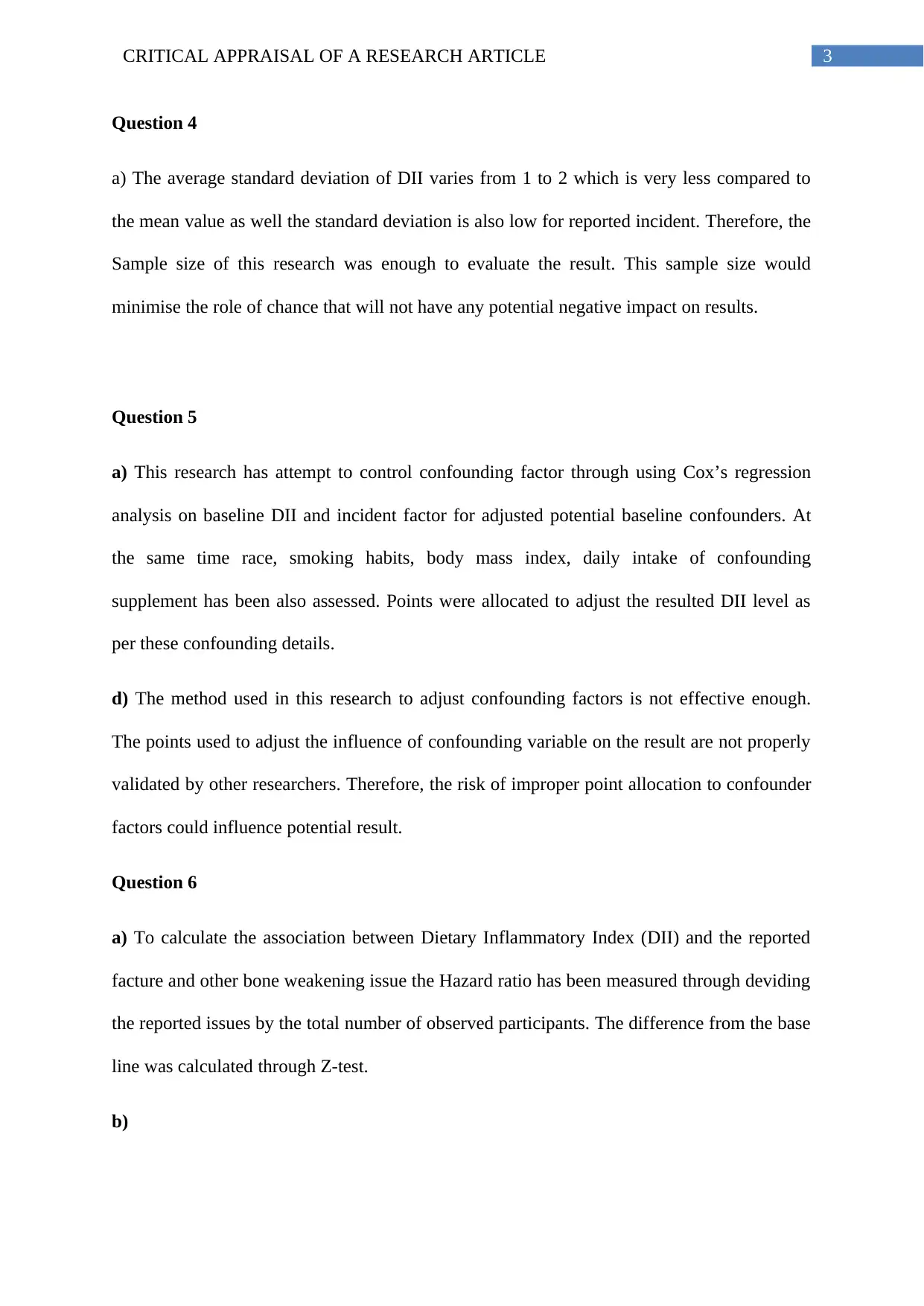
3CRITICAL APPRAISAL OF A RESEARCH ARTICLE
Question 4
a) The average standard deviation of DII varies from 1 to 2 which is very less compared to
the mean value as well the standard deviation is also low for reported incident. Therefore, the
Sample size of this research was enough to evaluate the result. This sample size would
minimise the role of chance that will not have any potential negative impact on results.
Question 5
a) This research has attempt to control confounding factor through using Cox’s regression
analysis on baseline DII and incident factor for adjusted potential baseline confounders. At
the same time race, smoking habits, body mass index, daily intake of confounding
supplement has been also assessed. Points were allocated to adjust the resulted DII level as
per these confounding details.
d) The method used in this research to adjust confounding factors is not effective enough.
The points used to adjust the influence of confounding variable on the result are not properly
validated by other researchers. Therefore, the risk of improper point allocation to confounder
factors could influence potential result.
Question 6
a) To calculate the association between Dietary Inflammatory Index (DII) and the reported
facture and other bone weakening issue the Hazard ratio has been measured through deviding
the reported issues by the total number of observed participants. The difference from the base
line was calculated through Z-test.
b)
Question 4
a) The average standard deviation of DII varies from 1 to 2 which is very less compared to
the mean value as well the standard deviation is also low for reported incident. Therefore, the
Sample size of this research was enough to evaluate the result. This sample size would
minimise the role of chance that will not have any potential negative impact on results.
Question 5
a) This research has attempt to control confounding factor through using Cox’s regression
analysis on baseline DII and incident factor for adjusted potential baseline confounders. At
the same time race, smoking habits, body mass index, daily intake of confounding
supplement has been also assessed. Points were allocated to adjust the resulted DII level as
per these confounding details.
d) The method used in this research to adjust confounding factors is not effective enough.
The points used to adjust the influence of confounding variable on the result are not properly
validated by other researchers. Therefore, the risk of improper point allocation to confounder
factors could influence potential result.
Question 6
a) To calculate the association between Dietary Inflammatory Index (DII) and the reported
facture and other bone weakening issue the Hazard ratio has been measured through deviding
the reported issues by the total number of observed participants. The difference from the base
line was calculated through Z-test.
b)
Paraphrase This Document
Need a fresh take? Get an instant paraphrase of this document with our AI Paraphraser
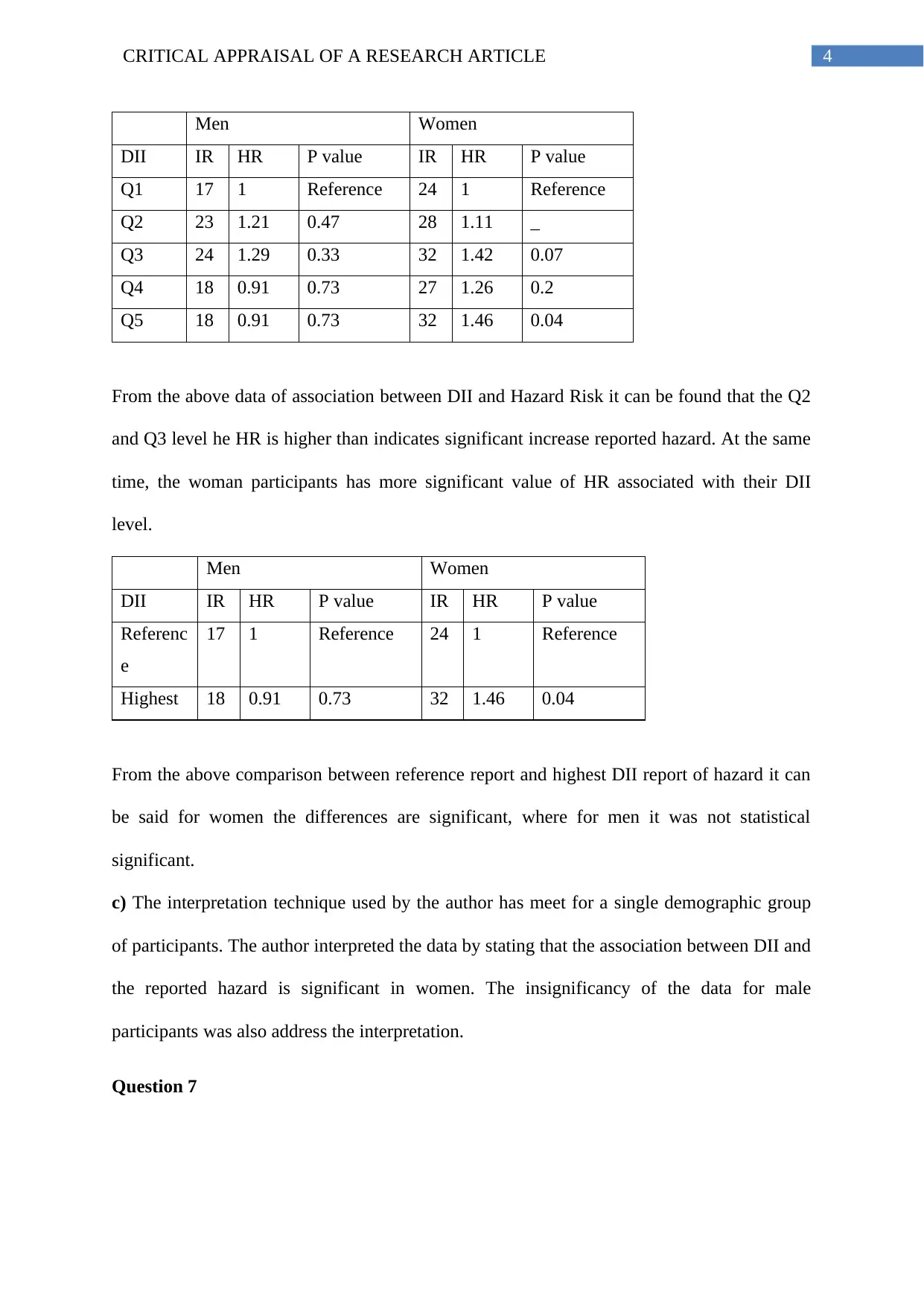
4CRITICAL APPRAISAL OF A RESEARCH ARTICLE
Men Women
DII IR HR P value IR HR P value
Q1 17 1 Reference 24 1 Reference
Q2 23 1.21 0.47 28 1.11 _
Q3 24 1.29 0.33 32 1.42 0.07
Q4 18 0.91 0.73 27 1.26 0.2
Q5 18 0.91 0.73 32 1.46 0.04
From the above data of association between DII and Hazard Risk it can be found that the Q2
and Q3 level he HR is higher than indicates significant increase reported hazard. At the same
time, the woman participants has more significant value of HR associated with their DII
level.
Men Women
DII IR HR P value IR HR P value
Referenc
e
17 1 Reference 24 1 Reference
Highest 18 0.91 0.73 32 1.46 0.04
From the above comparison between reference report and highest DII report of hazard it can
be said for women the differences are significant, where for men it was not statistical
significant.
c) The interpretation technique used by the author has meet for a single demographic group
of participants. The author interpreted the data by stating that the association between DII and
the reported hazard is significant in women. The insignificancy of the data for male
participants was also address the interpretation.
Question 7
Men Women
DII IR HR P value IR HR P value
Q1 17 1 Reference 24 1 Reference
Q2 23 1.21 0.47 28 1.11 _
Q3 24 1.29 0.33 32 1.42 0.07
Q4 18 0.91 0.73 27 1.26 0.2
Q5 18 0.91 0.73 32 1.46 0.04
From the above data of association between DII and Hazard Risk it can be found that the Q2
and Q3 level he HR is higher than indicates significant increase reported hazard. At the same
time, the woman participants has more significant value of HR associated with their DII
level.
Men Women
DII IR HR P value IR HR P value
Referenc
e
17 1 Reference 24 1 Reference
Highest 18 0.91 0.73 32 1.46 0.04
From the above comparison between reference report and highest DII report of hazard it can
be said for women the differences are significant, where for men it was not statistical
significant.
c) The interpretation technique used by the author has meet for a single demographic group
of participants. The author interpreted the data by stating that the association between DII and
the reported hazard is significant in women. The insignificancy of the data for male
participants was also address the interpretation.
Question 7
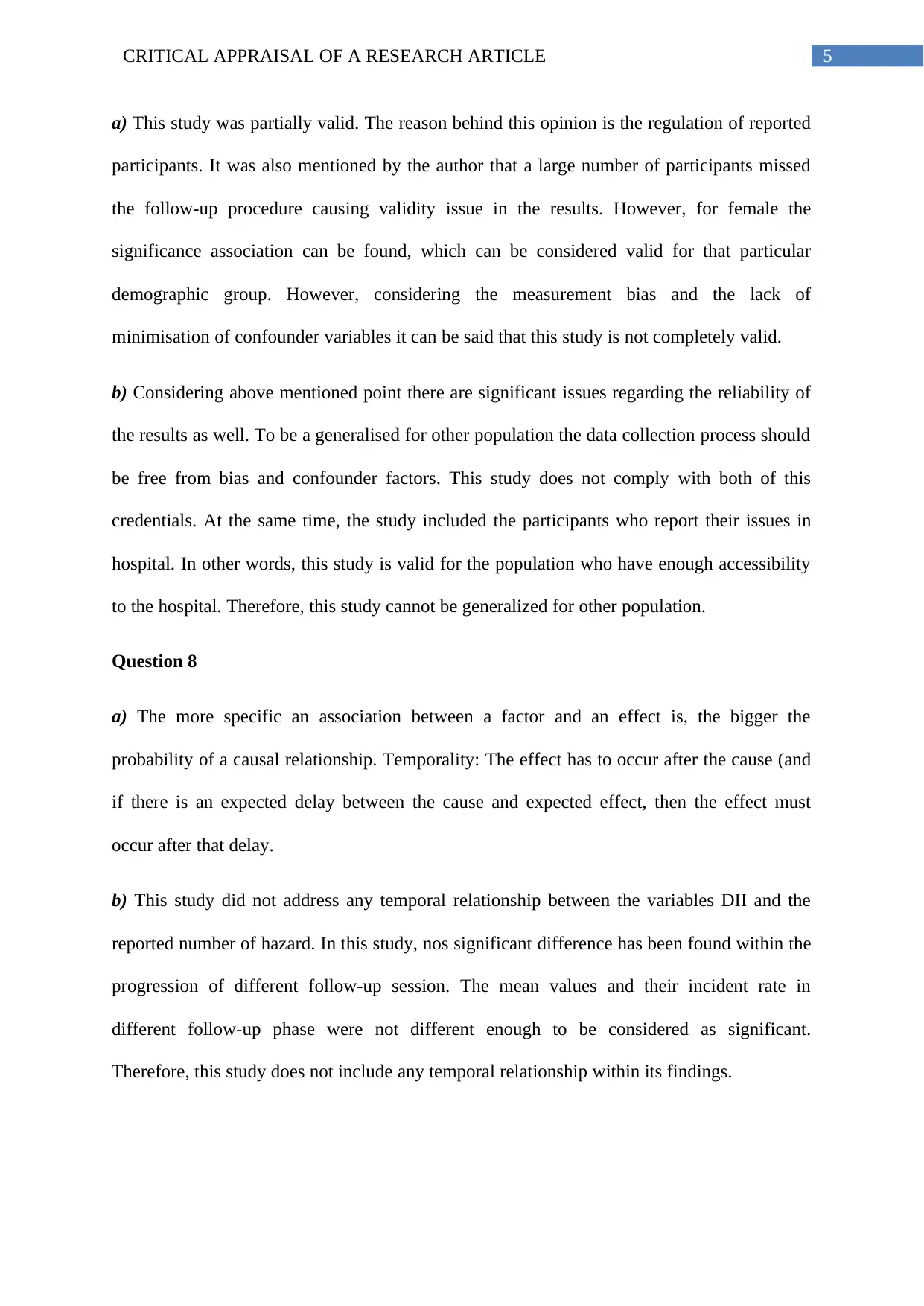
5CRITICAL APPRAISAL OF A RESEARCH ARTICLE
a) This study was partially valid. The reason behind this opinion is the regulation of reported
participants. It was also mentioned by the author that a large number of participants missed
the follow-up procedure causing validity issue in the results. However, for female the
significance association can be found, which can be considered valid for that particular
demographic group. However, considering the measurement bias and the lack of
minimisation of confounder variables it can be said that this study is not completely valid.
b) Considering above mentioned point there are significant issues regarding the reliability of
the results as well. To be a generalised for other population the data collection process should
be free from bias and confounder factors. This study does not comply with both of this
credentials. At the same time, the study included the participants who report their issues in
hospital. In other words, this study is valid for the population who have enough accessibility
to the hospital. Therefore, this study cannot be generalized for other population.
Question 8
a) The more specific an association between a factor and an effect is, the bigger the
probability of a causal relationship. Temporality: The effect has to occur after the cause (and
if there is an expected delay between the cause and expected effect, then the effect must
occur after that delay.
b) This study did not address any temporal relationship between the variables DII and the
reported number of hazard. In this study, nos significant difference has been found within the
progression of different follow-up session. The mean values and their incident rate in
different follow-up phase were not different enough to be considered as significant.
Therefore, this study does not include any temporal relationship within its findings.
a) This study was partially valid. The reason behind this opinion is the regulation of reported
participants. It was also mentioned by the author that a large number of participants missed
the follow-up procedure causing validity issue in the results. However, for female the
significance association can be found, which can be considered valid for that particular
demographic group. However, considering the measurement bias and the lack of
minimisation of confounder variables it can be said that this study is not completely valid.
b) Considering above mentioned point there are significant issues regarding the reliability of
the results as well. To be a generalised for other population the data collection process should
be free from bias and confounder factors. This study does not comply with both of this
credentials. At the same time, the study included the participants who report their issues in
hospital. In other words, this study is valid for the population who have enough accessibility
to the hospital. Therefore, this study cannot be generalized for other population.
Question 8
a) The more specific an association between a factor and an effect is, the bigger the
probability of a causal relationship. Temporality: The effect has to occur after the cause (and
if there is an expected delay between the cause and expected effect, then the effect must
occur after that delay.
b) This study did not address any temporal relationship between the variables DII and the
reported number of hazard. In this study, nos significant difference has been found within the
progression of different follow-up session. The mean values and their incident rate in
different follow-up phase were not different enough to be considered as significant.
Therefore, this study does not include any temporal relationship within its findings.
⊘ This is a preview!⊘
Do you want full access?
Subscribe today to unlock all pages.

Trusted by 1+ million students worldwide
1 out of 6
Related Documents
Your All-in-One AI-Powered Toolkit for Academic Success.
+13062052269
info@desklib.com
Available 24*7 on WhatsApp / Email
![[object Object]](/_next/static/media/star-bottom.7253800d.svg)
Unlock your academic potential
Copyright © 2020–2025 A2Z Services. All Rights Reserved. Developed and managed by ZUCOL.





